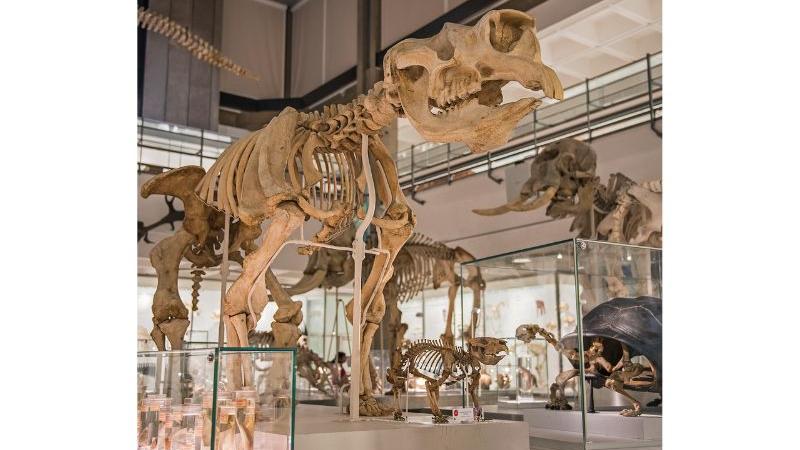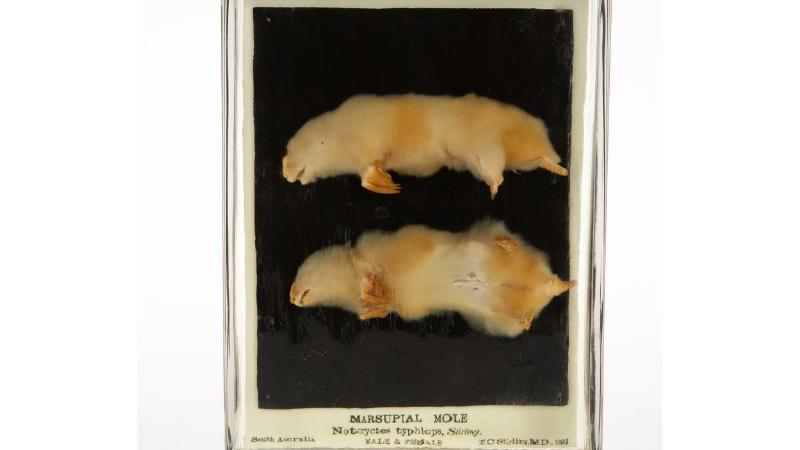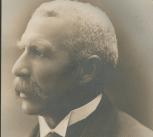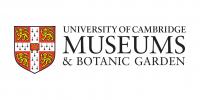What’s in the collection?
Some of the most prominent objects on display in the Museum, including the cast of the giant extinct wombat-relative Diprotodon in our Lower Gallery (which Stirling had made from original fossils at the South Australian Museum), and the pygmy right whale hanging from the ceiling.
Stirling also donated type specimens of the marsupial mole (the specimens used to scientifically describe the species), other Australian mammals, reptiles and fishes, plus fossils of the giant “thunderbird” Genyornis newtoni, which Stirling had named after Cambridge’s Professor of Zoology, Alfred Newton.

When did it arrive?
Most of the material was donated in 1891. The thunderbirds arrived in 1897, and the Diprotodon in 1902 and 1907.
What do we know about the specimens in Cambridge?
New mammal species are not described very often, particularly ones which surprised zoologists as much as marsupial moles did. Stirling wrote the first full scientific description of this species in 1891, naming it Notoryctes typhlops at Newton’s suggestion, and he then donated some of the specimens he used in the description to our museum. The Museum’s report for 1891 reads:
“The most important event in the year has been the presentation of a collection of Australian vertebrates by Dr E. C. Stirling, of Trinity College and the University of Adelaide. This collection includes several specimens of great value, and notably some examples of the remarkable Mole-like marsupial, Notoryctes typhlops, lately described for the first time by Dr Stirling”.
It's important to note that First Nations Australians have known about marsupial moles for tens of thousands of years, but the species first came to the attention of Western scientists when Stirling was sent an initial specimen in 1888 from Idracowra cattle station in the Northern Territory, about 100 miles from Charlotte Waters where another of our significant collections comes from [see 'Byrne']. It had been collected alive by station manager William Coulthard, and passed through various hands until it reached Stirling at the South Australian Museum. By then the specimen was not well preserved, and while Stirling was able to describe it as a burrowing animal, he could not determine anything about its relationships to other animals – or even whether it was a placental mammal (like us), a marsupial, or a monotreme (related to platypuses and echidnas) – and so did not give it a name. He said he needed to collect more specimens.
By 1890 European scientists had grown impatient with the lack of news about this intriguing animal – they thought it could have major implications for their understanding of zoology. The secretary of the Zoological Society of London, Philip Sclater wrote in Nature:
“On behalf of the zoologists of this country, who have waited patiently two years for further information, I now venture to urge Dr. Stirling to send one of his specimens of this extraordinary creature … to London, and allow us to endeavour to decide what it really is. I need not point out the extraordinary interest of this discovery. If a Monotreme, as seems probable, it will be the third known form of this very peculiar type of mammal-life; if a Marsupial, it is quite different from all known members of that group; and if it turns out to be a Placental Mammal, it will revolutionize our canons of zoological geography”.
There is more than a hint of colonial snobbery going on here, with Sclater thinking that scientific discoveries as important as this should happen in Europe, not Australia. Stirling struck back to say he thought Australia should be responsible for its own science, and having acquired 11 more specimens – some of which he subsequently sent to Cambridge – fully described the species in 1891. Some of these specimens were then sent on from Cambridge to museums in London, Berlin, Leiden, Stockholm and Paris.
Stirling made clear that it was First Nations Australians who were largely responsible for providing the specimens. Based on the location, this would have been Arrente people:
“With few exceptions the animals have been captured by the aboriginals, who, with their phenomenal powers of tracking, follow up their traces until they are caught.”
Marsupial moles have become a key example of convergent evolution: the process where the same traits evolve independently on different branches of the tree of life to solve the same ecological challenge. With “moles”, large digging arms, spade-like hands, a streamlined body with silky fur, and reduced eyes, have developed separately in the evolution of marsupial moles in Australia, golden moles in Africa (which are related to elephants), and talpid moles in Europe, Asia and North America.

Who was Edward Charles Stirling?

Edward Charles (Ted) Stirling was one of Australia’s leading zoologists and anthropologists of the late nineteenth and early twentieth centuries, and also worked as a surgeon. Born in South Australia and educated at the University of Cambridge, he became professor of physiology at the University of Adelaide (where he helped found the medical school) and honorary director of the South Australian Museum. Through these roles, he was key to the development of the scientific industry in Australia, allowing intellectual work about Australia to take place in the country itself, rather than be exported to London.
Stirling exhibits the complex histories of many colonial figures. His grandfather, Archibald Stirling (1769-1847) was a Scottish planter who owned shares in 690 enslaved people on plantations in Jamaica and received £12,500 in compensation when slavery was abolished. Archibald had illegitimate sons in Jamaica – one of whom was EC Stirling’s father, Edward (c.1808-1873), who was mixed race: his mother was Creole, and possibly called Jeanne or Jeannie. Many such children were abandoned by their white fathers, but Archibald took Edward to Scotland to be educated (although he was sent to live away from Archibald’s “legitimate” family) and later provided Edward with an advanced inheritance of £1000 to emigrate to South Australia in 1839 (this is a mix of both generosity and a desire to protect Archibald’s reputation by creating significant distance between himself and Edward). In Australia, Edward claimed lands belonging to the Peramangk people for sheep-farming. After some initial failings, Edward became a successful businessman in the colonial pursuits of farming, trading and mining, before being elected to the Legislative Council from 1856-1865.
Edward Charles had been born in 1848, and as a wealthy child of African descent in Adelaide’s relatively egalitarian society, he was able to thrive in school. Although his father appears to have worked to identify himself as a Scotsman rather than acknowledge his Jamaican routes, Edward Charles was given a derogatory nickname at school that highlighted his racial heritage.1
The family relocated to London for his further education, before he was admitted to Cambridge and subsequently took up his career in Adelaide from 1881.
As well as his contributions to science, Stirling also had a political career, elected to the South Australia’s Legislative Assembly from 1884-1887, during which time he became the first person in Australia to propose legislation enabling votes from women.
His role on various colonial scientific expeditions led him to develop a significant reputation as an anthropologist, and through this and his museum work was involved in the trade in Aboriginal remains.
References and further reading
1. Robertson, Beth M. (2022). "Edward Stirling: Embodiment and beneficiary of slave-ownership" (PDF). Australian Journal of Biography and History. 6 (6): 103–124.





